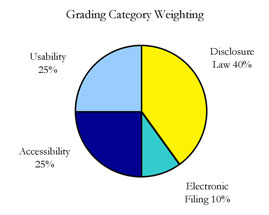|
The
Grading State Disclosure criteria were written
and developed by the California Voter Foundation
in consultation with the Grading State Disclosure
judges, the Campaign Disclosure Project Advisory
Board and project partners. The Project sets
a high, but not impossible, standard for
state campaign finance disclosure programs.
In developing the criteria, efforts were
made to balance the concerns of practitioners
and government officials with the need for
timely, complete, and effective disclosure.
The criteria used for this fifth round of grading
is unchanged from that used in the first four
rounds.
Four
areas of performance comprise the grading
criteria: Campaign Disclosure Laws; Electronic
Filing Programs; Disclosure Content Accessibility;
and Online Contextual and Technical Usability.
The strength of a state’s campaign disclosure
law is worth 40 percent of its grade; the quality
of electronic filing is worth ten percent;
and accessibility to data and web site usability
are each worth 25 percent.

A
300-point system was developed to score each
state. Points were awarded based on a state’s performance solely in the area
of state-level candidate disclosure. Ranks
were assigned based on points, and in several
instances one or more states tied for a particular
rank. This is especially the case in the Electronic
Filing category, where multiple states were
tied for both first and last place. Grades
are based on each state’s total point
score, utilizing the following grading percentages:
A: 90 – 100
percent (excellent)
B: 80 – 89 percent (good)
C: 70 – 79 percent (average)
D: 60 – 69 percent (below average/passing)
F: 59 percent or lower (failing)
In
addition to an overall grade and rank, the
states have also been graded and ranked in
each of the four grading categories. In order
to better measure progress over time, the
grades are not curved, weighted, or scaled.
|